Frank Carroll posted this link in a comment which I will post separately. There are a couple of different topics in this letter, including cost-sharing agreements, transparency and communication, including definitions of what is a full suppression strategy. It would be interesting to hear the FS side of this story.
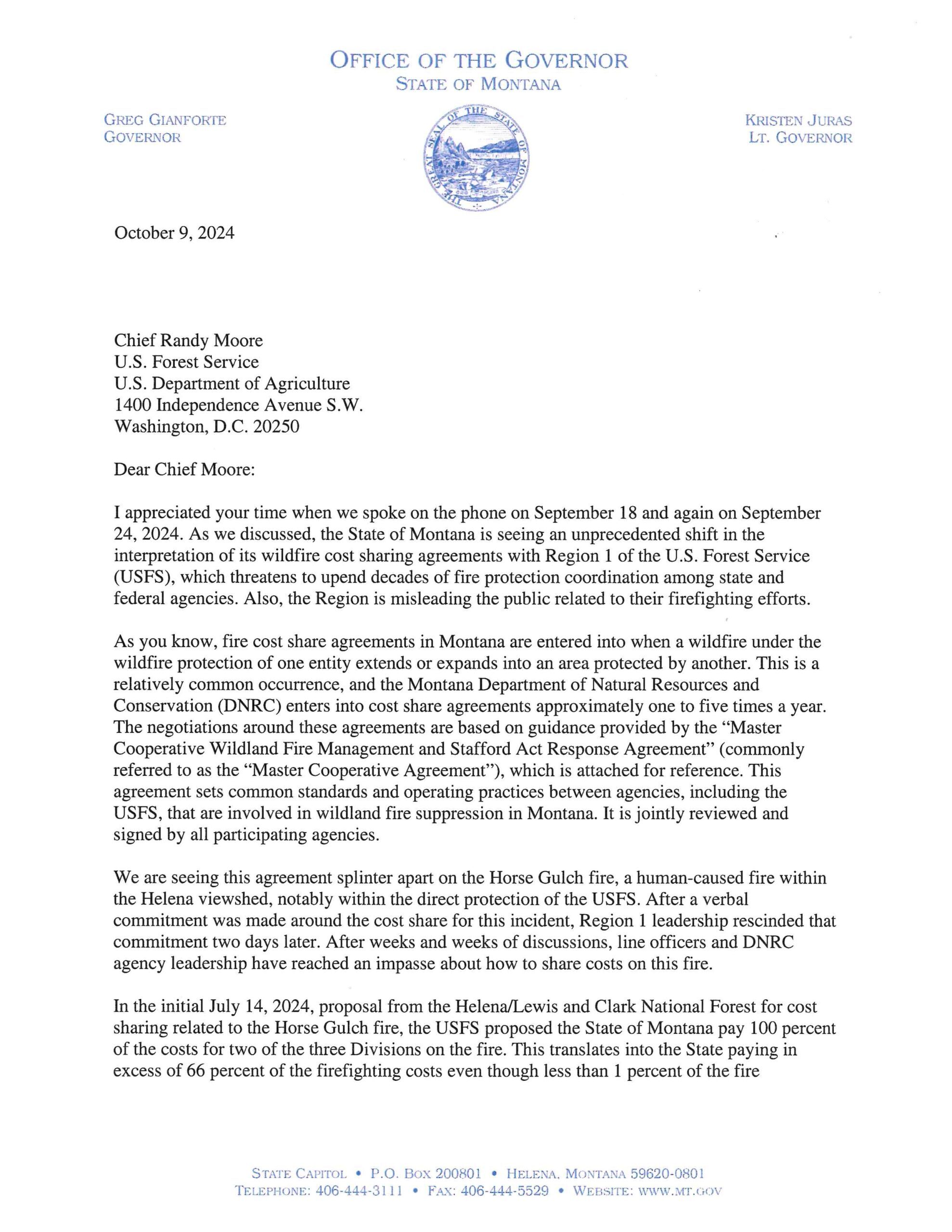
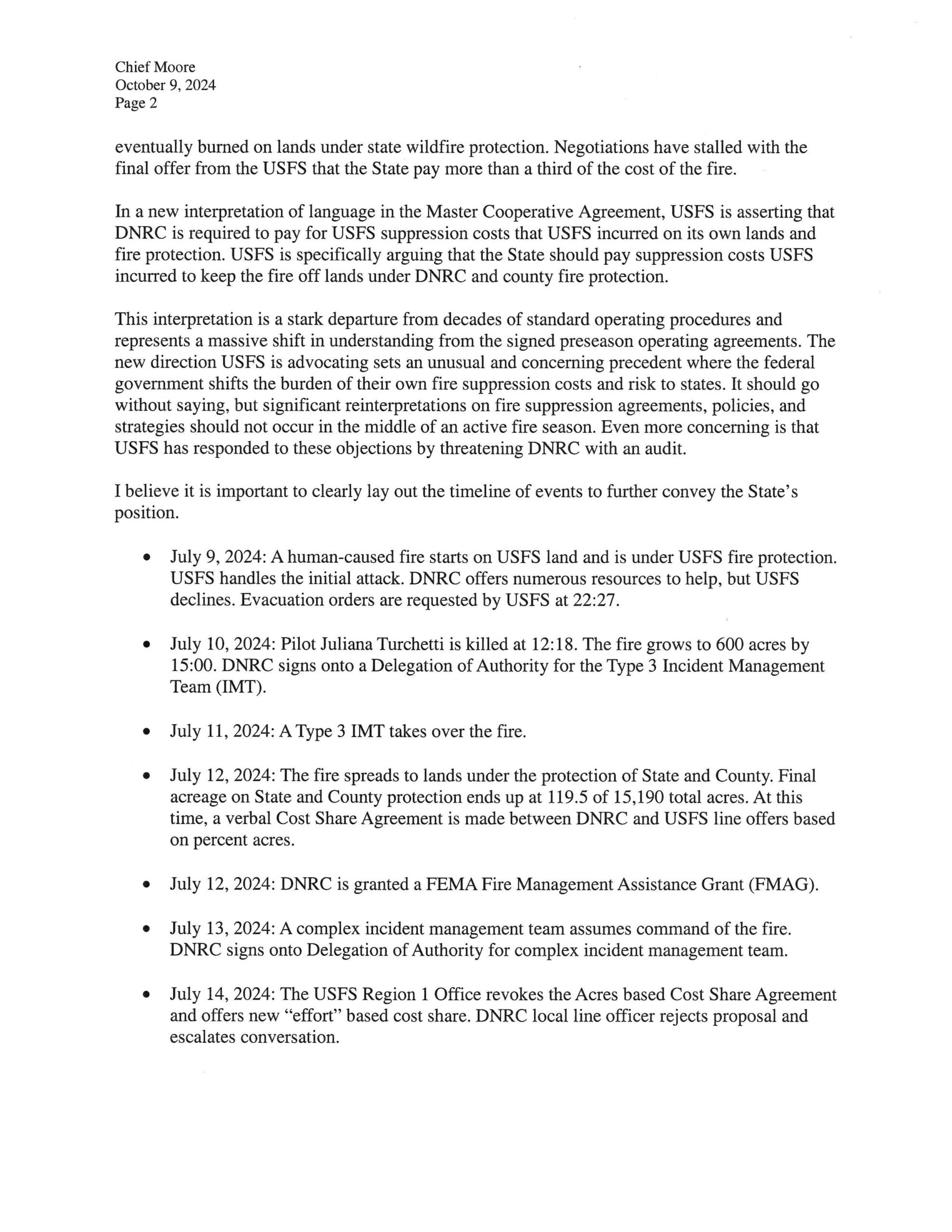
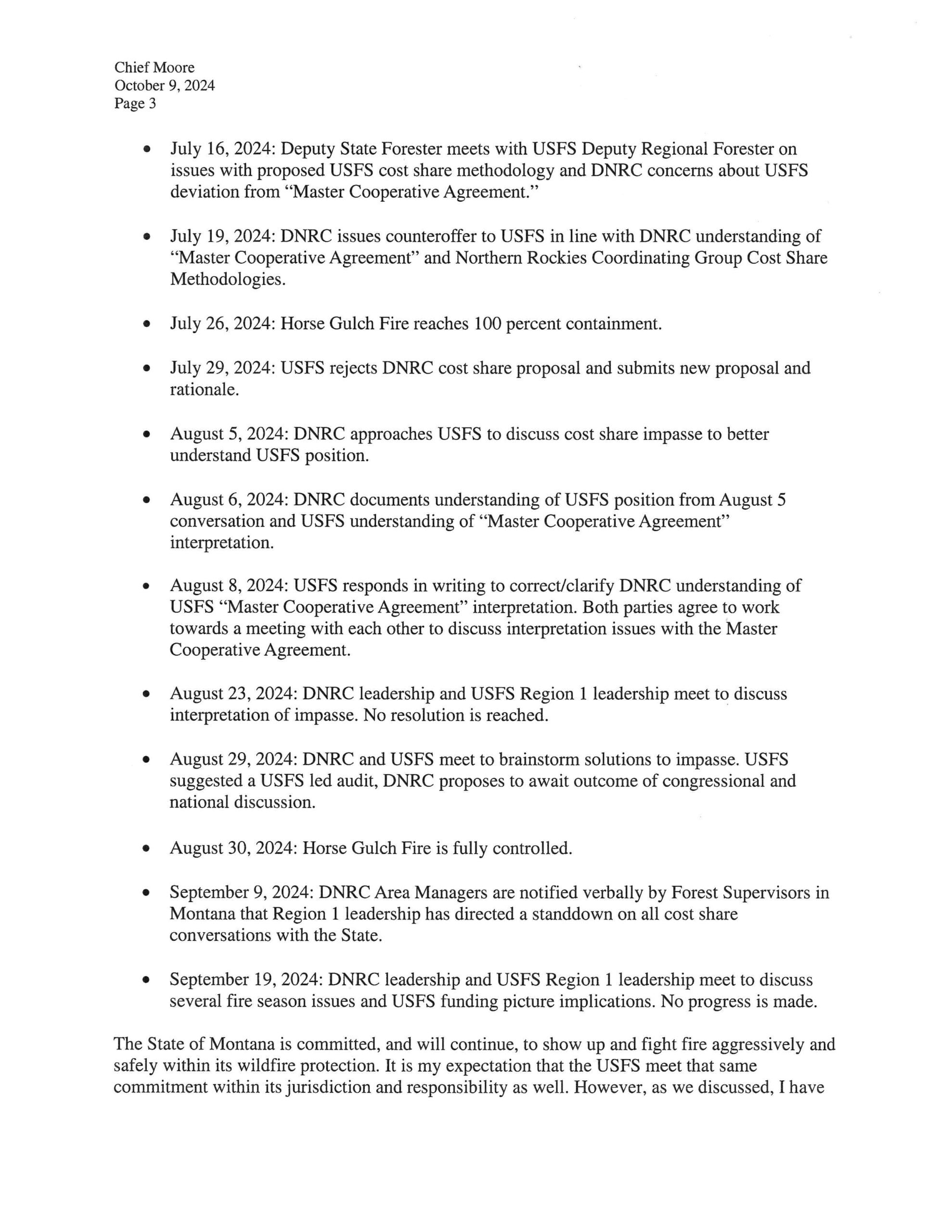
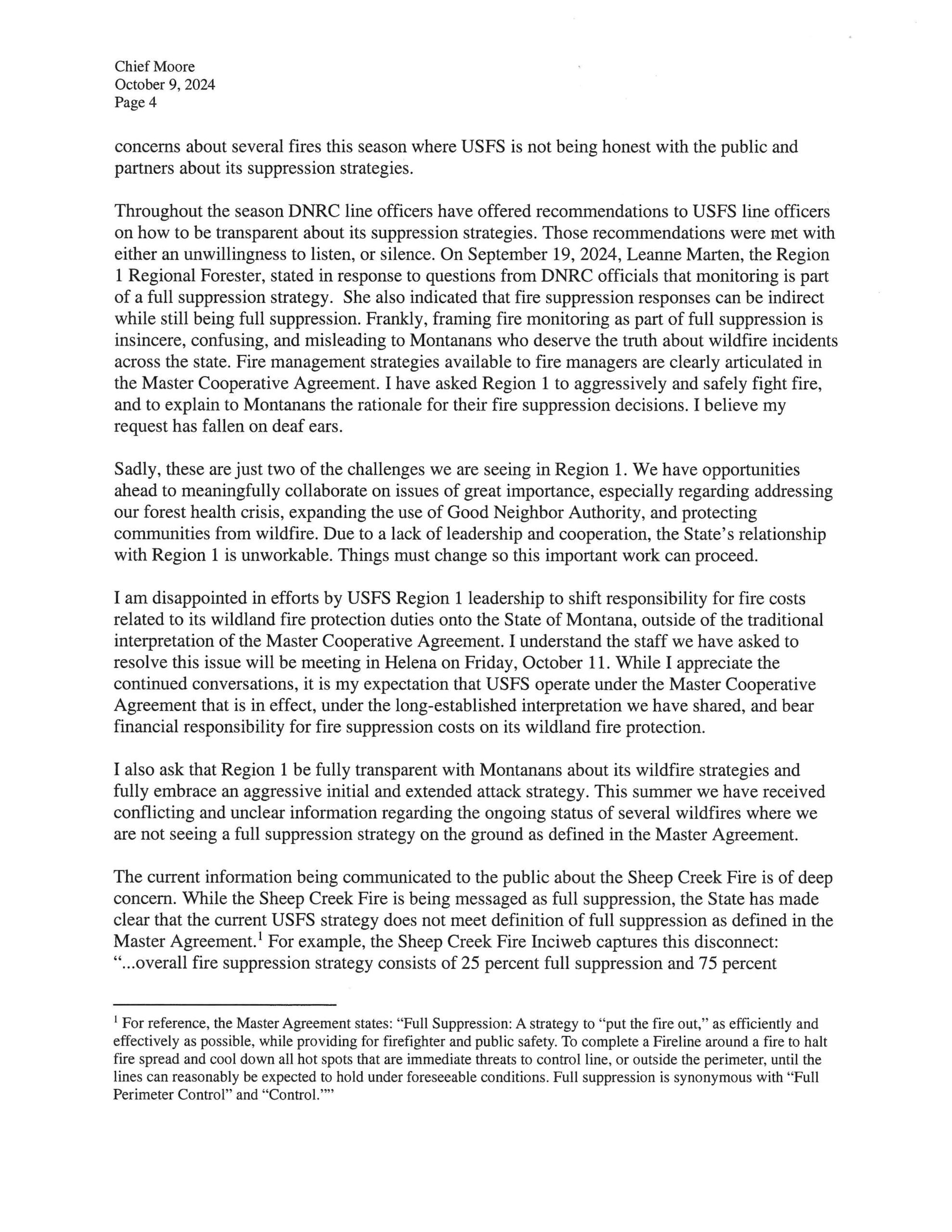
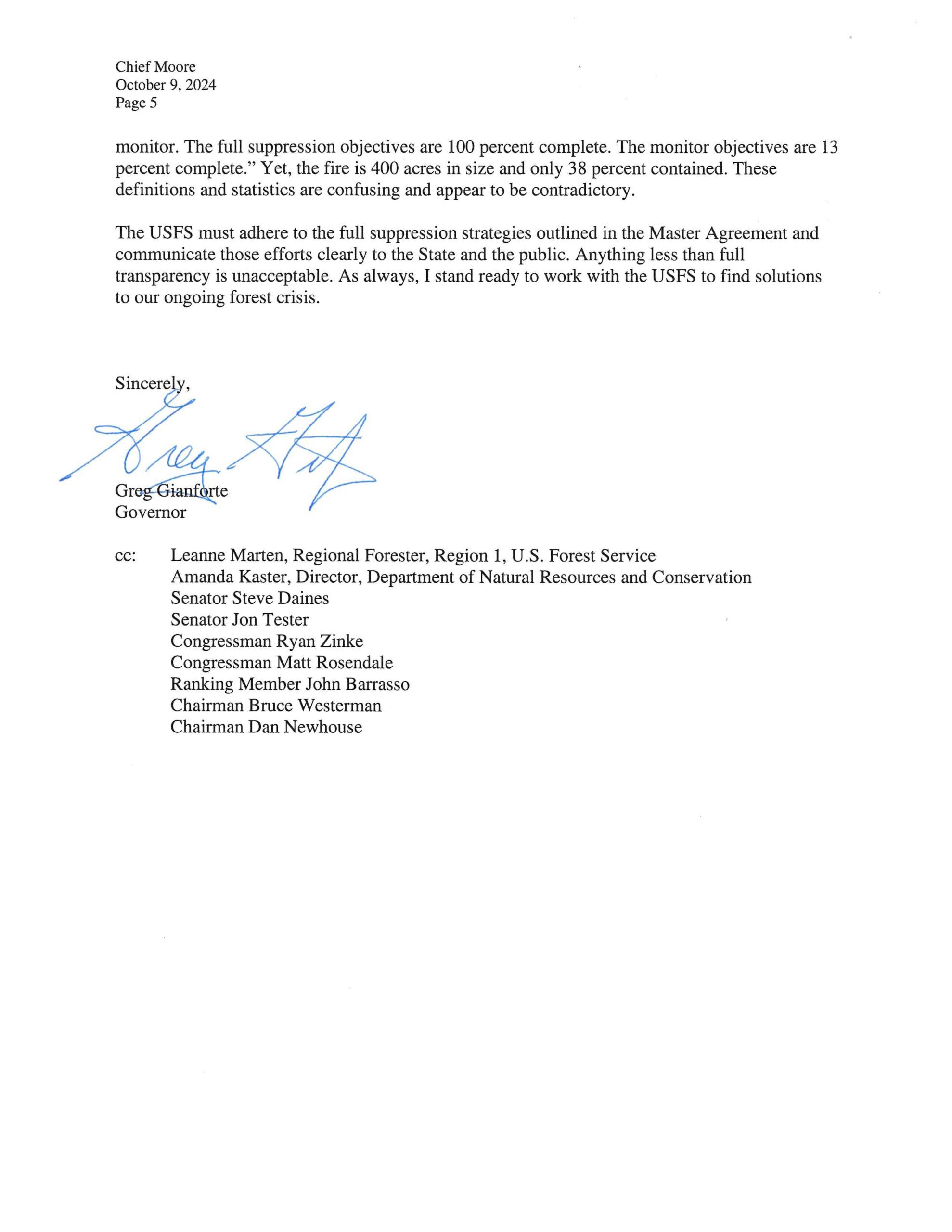 US:67d7585d-31e2-4587-a999-c60aabe128e2
US:67d7585d-31e2-4587-a999-c60aabe128e2
Montana Governor Gianforte wrote to the Chief to tell him that Montana would no longer participate in science fiction and that “full suppression” could be anything other than “anchor, flank, and hold.” Those of us working on this issue for the past decade are euphoric. Montana has removed any doubt that FS firefighters intentionally use wildfires to manage natural resources.
This development is critical for many reasons. First, Montana will no longer share the outrageous and growing costs of giant, summertime prescribed wildfires under the Master Agreement. The governor told the chief, “Either put the fire out immediately, or you’re on your own paying for your alternative strategies.” This is an astonishing and overdue development. Gianforte’s letter shatters the deception that the FS is working with cooperators, and everyone is on board with the wildfire use policy. They are not.
See my presentation here: https://1drv.ms/p/s!AuKr93RuXe49gbIHkbk4dY3DoqJvbA
With the FS budget in complete disarray and a billion dollars in the hole, the FS needs the states to participate to defray the high costs of current policies. The states are not sympathetic. Many key state leaders first heard the FS was expanding wildfires on purpose as a result of my work with Sarah Hyden, Joe Reddan, Van Elsbernd, Nadine Bailey, Quentin Rhoades, Roger Jaegle, and many others meeting for the past several years with states Attorneys General in Montana, Idaho, and others, and in multiple presentations to any significant group who would listen and buy us lunch. We lobbied Congress at home and in DC. We challenged the FS’s assertions of legal management strategies in meetings and in fire briefings.
The Governor’s letter clarifies that the vagaries of wildfire use and applied wildfire in PODs and firesheds is not a conspiracy theory or a figment of the imaginations of disgruntled former employees. Gianforte says it’s all too real, and he’s not playing.
I regret feeling so much affirmation after such a long fight, but I do, and it’s an important fight.
The days of the Chevron Deference ended in June this year. The time of National, Regional, and Unit EIS’s addressing wildfire use, disclosing impacts, inventorying the casualties to date, cooperating to forge robust public scoping and planning, and differences of opinion no longer ignored has come and I welcome it. The Chief will have to retire and make way for an effective and creative manager who can dig out of the mess.
The Forest Service is lost and struggling. The NLT, RFs, and Rangers have developed an unhealthy contempt for the mission. I think it blossomed in the pandemic. It manifests as arrogance and a complete lack of focus on the public. I went to the Boise Supervisor’s Office a few weeks ago. The Visitor Information Center was open, but no one staffed it except a lone federal security guard. He told me two women were supposed to be there but were “unreliable” and often not at their posts. He said I could try later, but there were no guarantees. Most of the staff was not there. The historic archive was thrown away by new kids who didn’t understand the need to preserve federal records. There were no principal staff officers ready to assist anyone.
The Chief and RFs allowed fear to rule from 2010 to today. The agency has been overcome by false constructs of employee health and wellness, now interpreted as meaning everyone can do whatever they want about coming to work (or not), showing up to work together to teach each other (or not), and interacting with the public (or not).
Employees are allowed to stay home. GS Fantastics in the 13-15 range live in their awesome refuges at home or wherever they want, traveling at will to spendy locations and racking up huge expenses. No one is going to work. There’s no opportunity for new kids to learn from old hands. They are lost and afraid. It’s a perfect storm of a once-powerful and now inert agency no longer able to muster a relevant presence on the ground.
I didn’t believe it when I first heard it, but the folks at the top came up with solutions to the current budget shortfall last month that beggars the imagination. The first idea was not to hire the seasonal workforce; now, it’s a solid plan bemoaned by High Country News. The Second was to consolidate Ranger Districts. Hopefully, this nutty idea was stillborn. There was no one with enough courage to enter into a Reduction in Force focused not on seasonals but on the herds of GS-13-15 planning staffers, teams scions, and others at the WO, Region, and Forest level who now constitute the bulk of the nondiscretionary workforce. Lol!! What?? Now is the time for buy-outs and mass reassignments.
The Chief disingenuously claims the current permanent staff will take up the seasonal slack, opening trails, cleaning campgrounds, and handling the work the public expects and deserves to have as support for their use of their lands. What the hell happened to leaders who knew how to lead? What happened to the Forest Service?
In any event, the States are no longer interested in enabling the once iconic agency to fail to grasp its own mission. They are saying, not theoretically, that they are not paying for the pretend party in the halls of the now-empty Forest Service offices (where we are still paying rent and utilities for no-show staff). I’ll stop here lest my fury overcome my message. Suffice it to say that the era of irresponsible, anti-public service, union-driven craziness, and a goofy, indefensible assertion of “safetiness,” is coming to a crashing end: Just in time.
Please read the attached letter several times and rejoice. It took a Governor to drag us back to reality. The entire workforce and lots of accountability will drag the FS back from the brink.
I remain optimistic. My Dad and I served from 1943 to 2011. We know how to do stuff and we can do it with unafraid leaders. We may have the chance to go back to the future with Elon Musk in charge of government reform.
Sharon said: “It would be interesting to hear the FS side of this story.”
This story gives a little bit of Horse Gulch background:
https://billingsmix.com/forest-service-not-playing-nice-montana-wildfires-2/
Key paragraph:
“The Forest Service is arguing that they suppressed the fire on their lands that also threatened to spread onto sections under DNRC and county jurisdiction. Since the Feds preempted the wildfire invading state lands, the state should help defray the cost.”
The Missoulian is also running a story, but it’s moneywalled:
https://missoulian.com/news/state-and-regional/gianforte-letter-accuses-usfs-of-overcharging-state-for-horse-gulch-fire/article_a9a0363f-26d9-5162-96df-40a45699759b.html
The FS-MT cooperative agreement is here:
https://dnrc.mt.gov/_docs/forestry/Wildfire/agreements-plans-guides/Six-Party-FINAL-23FI0156048_MTDNRC-OtherFeds_MontanaStatewideMasterCFMA_OP_EXECUTED.pdf
Thanks, Rich! That statement as quoted seems like it could be a slippery slope..wouldn’t almost any wildfire be at some risk of slopping onto private or State lands if it weren’t suppressed?
Absolutely. I have only limited sympathy for either side here.
1) The FS apparently wanted payment from MT for fire management actions that protected MT state lands. But the FS definition (in the cooperative agreement) of such actions extended well beyond active suppression (to include ‘monitoring’ among other things). The FS was (it appears) asking for reimbursement from MT for fire management expenses that state law prohibited the legislature from approving with respect to state lands. But the fire barely burned any state lands..
2) The Horse Gulch fire burned barely more than a quarter section of state land, miniscule in comparison with total acres burned. Somewhere in the West a quarter section has burned as I type this. The idea that the federal government could demand confiscatory sums for an amount of fire damage that occurs on average (in the 11 contiguous western states) every 36 hours is ludicrous. And besides, when the feds are operating in a given state, they must adhere to state laws.
It’s that last sentence that is, at the end of the day, the problem. By definition, no federal employee works, or can work, for Governor Gianforte. Whatever the legal merits of his letter (and they are, imho, limited) no federal employee can, in the course of his or her employment, maintain that a state governor has supremacy over the president and congress. It’s fine if you believe that, but you’ll have to draw your check from a source other than the US treasury.
All this said, on the limited information I have, Region 1 probably effed up here. The facts are bad – however many state acres R1 saved, only a small number actually torched. I understand that R1 did not want to set a precedent (and that the whole Holland Lake thing did not go well and has put the region in an unfavorable position). But one must pick a hill to die on, and the Horse Gulch fire was an especially inauspicious hill. The region should have, in my view, given Gianforte his pound of flesh and moved on, not because he was right, but because the world continues to turn.
Activists (from any side) may scoff at that last sentence. Spend a week driving US 93 and get back to me.
I never posted the interview I did with various special uses folks about Holland Lake.
Basically, the issue was so complicated (something like “when does ownership really transfer.. when the FS can’t watch the funding in real time?”) that last I heard, the FS had to issue new guidance. Special uses, including recreation special uses, is quite complicated and often it’s just “other duties as assigned” to someone with an overwhelming recreation workload.
So it was surprising to me that UM academics, and their own Senator (!) (whose staff certainly knows better) chose to assume the worst about the Forest’s intentions and (most irritating to me) spread misinformation about CEs.
https://forestpolicypub.com/2023/04/17/senator-tester-spreads-misinformation-about-forest-service-use-of-categorical-exclusions-at-senate-hearing/
Montana had three major transcontinental railroads: Great Northern, Milwaukee Road and Northern Pacific. The Unclaimed public domain removed from homestead acts was checkerboarded with Railroad sections sold and unsold. So 25 years ago R-1 determined Western Montana was home to too many homes and their existence made fire fighting too costly. Recommended a 30 mile no dwelling buffer between USFS land and Developed private land. The first question was who and how would the “taking” be paid? It went nowhere. That mentality just dug in.
I want answers how FEMA gets $3.85 Billion from Congress desicated solely to paying victims of escaped prescription fire, albeit well over 300,000 acres of public and private land. Applications are being shutdown in early November. $1.4 Billion has been paid to 10,450+ victims: governments, private enterprises, homes and home stead’s, tribal assets. That leaves $2.4 Billion budgeted by Congress. How will Homeland Security misuse that money appropriated as a rider on an Ukraine Aid bill be accounted for? Charter more planes for illegal alien night flights? When you find out FEMA is STILL PAYING Tropical storm Rita damages…..you are left breathless.
The Chief Moore unplanned ignition prescribed fire orders are disingenuous and despotic. He should know that “PODs” is not a new concept. Philadelphia used that concept to fight row house slum fires. Let the fire burn a whole block. Defend a perimeter. Urban Renewal District city management strategy.
The Supremacy Clause protects totally a federal employee following a burn plan. Not matter how much the planned fire burns as an “unplanned ignition source.” That is the BS the Montana Governor is calling foul play. And the best way to fight that is to first quit digging that hole deeper. A time for real “cancel culture.” Never forget, What the Constitution does not specifically reserve for the federal government is a state’s right. Gigantforte has standing.